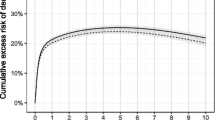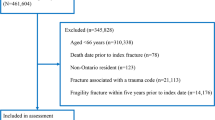Abstract
Summary
Comorbidity and hip fracture independently increased mortality risk for 9 years in both sexes, with a significant additive interaction in the first year among women and through 6 years among men.
Introduction
Hip fracture is associated with a persistently elevated mortality risk, but it is unknown whether the elevated risk is due to the fracture or to pre-fracture comorbidity.
Methods
In a population-based study in Singapore with 9 years of follow-up, patients age > 50 with first hip fracture from 2008 to 2017 were pair-matched to a cohort without hip fracture by age, sex, ethnicity, and pre-fracture Charlson Comorbidity Index (CCI). We investigated additive interaction using the relative excess risk due to interaction (RERI) and multiplicative interaction using the ratio of relative risks.
Results
Twenty-two thousand five hundred ninety of 22,826 patients with a first hip fracture in 2008–2017 were successfully matched. Hip fracture and comorbidity independently increased mortality risk for 9 years in both sexes. After adjustment for comorbidity, excess mortality risk continued to persist for 9 years post-fracture in both men and women. Women with a hip fracture and pre-fracture CCI > 4 had a higher relative risk (RR) of mortality at 9 years of 3.29 [95% confidence interval (CI) 3.01, 3.59] than those without comorbidity (RR 1.51, 95%CI 1.36, 1.68) compared to the referent without hip fracture or comorbidity. An additive interaction between hip fracture and pre-fracture CCI > 4 was observed in the first post-fracture year` [relative excess risk due to interaction (RERI) 1.99, 95%CI 0.97, 3.01]. For men with CCI ≥ 4, the positive additive interaction was observed through 6 years.
Conclusions
Excess mortality risks post-fracture are attributable to both the fracture and pre-fracture comorbidity. Early interventions in hip fracture patients with high comorbidity could reduce their excess mortality.

Similar content being viewed by others

Data availability
Not available.
References
Haentjens P, Magaziner J, Colon-Emeric CS et al (2010) Meta-analysis: excess mortality after hip fracture among older women and men. Ann Intern Med 152(6):380–390
Yong EL, Ganesan G, Kramer MS, Logan S, Lau TC, Cauley JA, Tan KB (2019) Hip fractures in Singapore: ethnic differences and temporal trends in the new millennium. Osteoporos Int 30(4):879–886
Pedersen AB, Ehrenstein V, Szepligeti SK et al (2017) Thirty-five-year trends in first-time hospitalization for hip fracture, 1-year mortality, and the prognostic impact of comorbidity: a Danish nationwide cohort study, 1980-2014. Epidemiology. 28(6):898–905
Roche JJ, Wenn RT, Sahota O, Moran CG (2005) Effect of comorbidities and postoperative complications on mortality after hip fracture in elderly people: prospective observational cohort study. BMJ. 331(7529):1374
Vestergaard P, Rejnmark L, Mosekilde L (2007) Increased mortality in patients with a hip fracture-effect of pre-morbid conditions and post-fracture complications. Osteoporos Int 18(12):1583–1593
Lawrence VA, Hilsenbeck SG, Noveck H, Poses RM, Carson JL (2002) Medical complications and outcomes after hip fracture repair. Arch Intern Med 162(18):2053–2057
Yong EL, Ganesan G, Kramer MS, Howe TS, Koh JSB, Thu WP, Logan S, Cauley JA, Tan KB (2020) Risk factors and trends associated with mortality among adults with hip fracture in Singapore. JAMA Netw Open 3(2):e1919706
Lunde A, Tell GS, Pedersen AB, Scheike TH, Apalset EM, Ehrenstein V, Sørensen HT (2019) The role of comorbidity in mortality after hip fracture: a nationwide Norwegian study of 38,126 women with hip fracture matched to a general-population comparison cohort. Am J Epidemiol 188(2):398–407
LeBlanc ES, Hillier TA, Pedula KL, Rizzo JH, Cawthon PM, Fink HA, Cauley JA, Bauer DC, Black DM, Cummings SR, Browner WS (2011) Hip fracture and increased short-term but not long-term mortality in healthy older women. Arch Intern Med 171(20):1831–1837
Wang CB, Lin CF, Liang WM et al (2013) Excess mortality after hip fracture among the elderly in Taiwan: a nationwide population-based cohort study. Bone. 56(1):147–153
Yoon HK, Park C, Jang S, Jang S, Lee YK, Ha YC (2011) Incidence and mortality following hip fracture in Korea. J Korean Med Sci 26(8):1087–1092
Chau PH, Wong M, Lee A, Ling M, Woo J (2013) Trends in hip fracture incidence and mortality in Chinese population from Hong Kong 2001-09. Age Ageing 42(2):229–233
Chan CQH, Lee KH, Low LL (2018) A systematic review of health status, health seeking behaviour and healthcare utilisation of low socioeconomic status populations in urban Singapore. Int J Equity Health 17(1):39. https://doi.org/10.1186/s12939-018-0751-y
Charlson ME, Pompei P, Ales KL, MacKenzie CR (1987) A new method of classifying prognostic comorbidity in longitudinal studies: development and validation. J Chronic Dis 40(5):373–383
VanderWeele TJ, Vansteelandt S (2014) Invited commentary: some advantages of the relative excess risk due to interaction (RERI)--towards better estimators of additive interaction. Am J Epidemiol 179(6):670–671
Hosmer DW, Lemeshow S (1992) Confidence interval estimation of interaction. Epidemiology. 3(5):452–456
Bruun NH, Fenger-Gron M, Prior A (2015) IC: Stata module to compute measures of interaction contrast (biological interaction). Statistical Software Components S457975, Boston College Department of Economics, Revised 22 Apr 2017
Bliuc D, Nguyen ND, Milch VE, Nguyen TV, Eisman JA, Center JR (2009) Mortality risk associated with low-trauma osteoporotic fracture and subsequent fracture in men and women. JAMA. 301(5):513–521
Jurisson M, Raag M, Kallikorm R, Lember M, Uuskula A (2017) The impact of comorbidities on hip fracture mortality: a retrospective population-based cohort study. Arch Osteoporos 12(1):76
Riska BSL, Forsen L, Omsland TK, Sogaard AJ, Meyer HE, Holvik K (2018) Does the association of comorbidity with 1-year mortality after hip fracture differ according to gender? The Norwegian epidemiologic osteoporosis studies (NOREPOS). J Am Geriatr Soc 66(3):553–558
Mazzucchelli R, Perez Fernandez E, Crespi-Villarias N et al (2018) Trends in hip fracture in patients with rheumatoid arthritis: results from the Spanish National Inpatient Registry over a 17-year period (1999-2015). TREND-AR study. RMD Open 4(1):e000671
Guzon-Illescas O, Perez Fernandez E, Crespi Villarias N et al (2019) Mortality after osteoporotic hip fracture: incidence, trends, and associated factors. J Orthop Surg Res 14(1):203
Lystad RP, Cameron CM, Mitchell RJ (2017) Mortality risk among older Australians hospitalised with hip fracture: a population-based matched cohort study. Arch Osteoporos 12(1):67
United Nations Development Program. Human Development Indices and Indicators - 2018 Statistical Update (2018) http://hdr.undp.org/sites/default/files/2018_human_development_statistical_update.pdf:Last accessed on 26 August 2019
Code availability
Yes.
Author information
Authors and Affiliations
Corresponding author
Ethics declarations
Consent to participate
Not applicable.
Consent for publication
Not applicable.
Conflicts of interest
None.
Additional information
Publisher’s note
Springer Nature remains neutral with regard to jurisdictional claims in published maps and institutional affiliations.
MHL and GG are joint first authors.
Rights and permissions
About this article
Cite this article
Liow, M., Ganesan, G., Chen, J. et al. Excess mortality after hip fracture: fracture or pre-fall comorbidity?. Osteoporos Int 32, 2485–2492 (2021). https://doi.org/10.1007/s00198-021-06023-0
Received:
Accepted:
Published:
Issue Date:
DOI: https://doi.org/10.1007/s00198-021-06023-0



